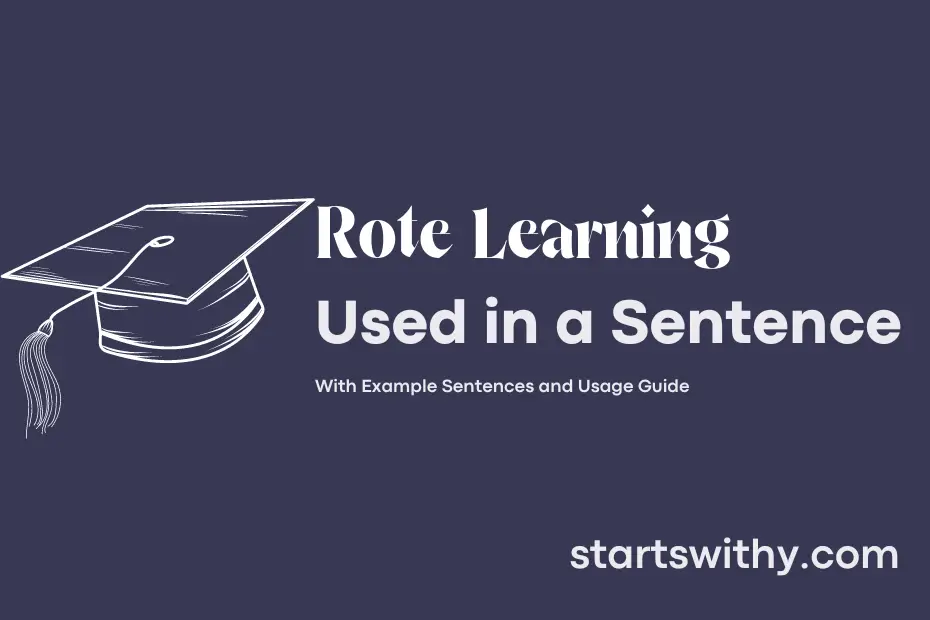Have you ever heard of the term “rote learning”? It refers to a memorization technique where information is learned through repetition without necessarily understanding the underlying concepts.
This method of learning is often criticized for promoting quick forgetting and hindering critical thinking skills. However, it can be useful for memorizing facts or formulas in a short period of time.
7 Examples Of Rote Learning Used In a Sentence For Kids
- Rote learning is when you memorize things by repeating them many times.
- When we do rote learning, we remember things by saying them over and over.
- Rote learning helps us remember facts, numbers, and names easily.
- Practice helps us get better at rote learning.
- Teachers sometimes use rote learning to help students remember important information.
- With rote learning, we can remember our ABCs and 123s.
- It’s important to practice rote learning to improve our memory skills.
14 Sentences with Rote Learning Examples
- Rote learning can be beneficial when studying for multiple choice exams.
- Some students rely on rote learning to memorize formulas for their math and science exams.
- Many college students in India use rote learning as a method to remember historical dates and events.
- When preparing for language courses, some students find success through rote learning of vocabulary.
- Engineering students often resort to rote learning to remember complex algorithms and equations.
- For some students, rote learning is the only way to remember the intricacies of organic chemistry reactions.
- Memorizing anatomy diagrams through rote learning is standard practice for medical students.
- In order to pass their entrance exams, many students practice rote learning of general knowledge questions.
- To prepare for law school exams, students may employ rote learning of legal theories and case laws.
- When faced with a large amount of information to remember, utilizing rote learning techniques can be helpful.
- Some students prefer rote learning over critical thinking when it comes to memorizing historical speeches.
- In order to excel in computer programming courses, students often resort to rote learning of coding syntax.
- Using rote learning to remember important dates in Indian history can help students excel in their exams.
- Business students often resort to rote learning of financial formulas and theories in order to succeed in their courses.
How To Use Rote Learning in Sentences?
To effectively use Rote Learning, first select the information you want to memorize. For example, you can choose to memorize vocabulary words, historical dates, or mathematical formulas. Once you have your material ready, create a quiet and distraction-free study environment where you can focus.
Next, start by reading the information you want to memorize multiple times. Repetition is key in Rote Learning as it helps reinforce the information in your memory. After reading the material, try to recite it from memory. If you forget any parts, go back and review them before moving on.
As you continue to practice, incorporate different techniques to help reinforce your memory. This can include writing the information down, making flashcards, or using mnemonic devices to aid in recall.
It is important to space out your Rote Learning sessions over several days to help solidify the information in your long-term memory. Regular review is crucial in retaining the material you have memorized.
Finally, test yourself periodically to assess your progress. By actively engaging with the material through practice quizzes or self-tests, you can identify areas that need further review.
In conclusion, Rote Learning can be a valuable tool for memorizing information quickly and efficiently. By following these steps and being consistent in your practice, you can improve your recall and retention of important details.
Conclusion
In conclusion, rote learning involves memorizing information through repetition without fully understanding the underlying concepts. This method can be effective for quickly acquiring facts and figures, as demonstrated by students who excel at reciting formulas or lists verbatim. However, rote learning often results in superficial understanding and hinders critical thinking skills and problem-solving abilities.
While rote learning can be a useful tool for certain subjects or tasks, it is important to balance it with other learning approaches that foster deeper comprehension and application of knowledge. By combining rote learning with interactive and experiential methods, individuals can enhance their understanding, retention, and practical use of information in a more holistic manner.



